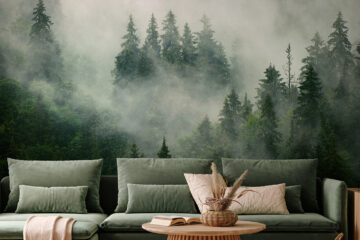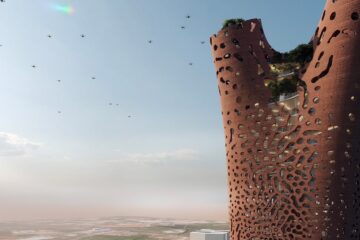International Garden Festival: The 22nd Edition of the Unveiling of the New Gardens
Spring is in the air, and there’s no better way to celebrate the blooming flowers and captivating foliage than through the unveiling of the new gardens of the 22nd edition of the International Garden Festival.
Every year, the International Garden Festival takes place at the Redford Gardens, considered to be one of the premier gardens in North America. Created by the avid gardener, Elsie Reford, from 1926 to 1958, the gardens were declared a national historic site by the Historic Sites and Monuments Board of Canada in 1995.
Since its inaugural year in 2000, and as the biggest contemporary garden festival in North America, the festival has welcomed more than one million visitors, witnessing almost 200 installations designed by world-renowned landscape architects, architects and artists.
The theme of this year’s 22nd edition of the festival is “Magic Lies Outside”, striving to bring hope, inspire creativity and brighten the world through its blossom-filled gardens.
With a total of 160 project proposals from 17 countries, only the cream of the crop were selected to be integrated around the existing gardens to create an open-air museum for visitors to explore. The five gardens selected for 2021 include proposals from designers located in Lyons, Québec City, Montreal, New York and Stockholm.
Porte-Bonheur, submitted from Lyons, France
The concept of “Porte-Bonheur” comes from designer Laura Giuliani, architect David Bonnard and visual artist Amelie Vale. Their experience and expertise in their fields allowed them to brainstorm and explore topics that they found interesting, one being the idea of “playgrounds”.
Giuliani, Bonnard and Vale confronted their varying ethical, sustainable, responsible and social approaches to the environment, more specifically to the garden, to create Porte Bonheur. The project plays on the French words “porte-bonheur” meaning “lucky charm”, and the word “porte”, which means “door” in English. Doors, always considered a gateway into something new and adventurous, have taken on a different meaning over the past year. Many of us have experienced doors closing, literally and figuratively, keeping us apart from our loved ones, and from the experiences that colour our lives and memories. The garden is described as a “rite of passage between reality and potentiality”, inviting visitors to open new doors, to go outside and to explore their surroundings with all the wonder of a child.
Open Space, submitted from Quebec City, Canada
Created by designers Gabriel Lemelin, Francis Gaignard and Sandrine Gaulin, “Open Space” is an example of how they see every project they work on as an opportunity to find new ways of interacting with the public. Their projects exploit the unique possibilities and qualities of the world around us – Open Space being no exception to that exploitation.
The project reflects its name – the walls of the house were opened up to create an open space, allowing it to take on new meaning. The project encourages the imagination to run wild by imagining where one could wander around in such openness. Lemelin, Gaignard and Gaulin have cleverly taken a house, a symbol representative of the lockdown over the past year, and made it go back to being a fun, safe and familiar place where you can let your imagination run wild.
Choose Your Own Adventure, submitted from New York, United States
Partners Noemie Lafaurie-Debany and Javier Gonzalez-Campana of Balmori Associates, Landscape and Urban Design, along with their associates Chris Liao, Simon Escabi and Cristina Preciado, created the vision behind “Choose Your Own Adventure”. The main tenet of their work is to set up a different type of relationship between ourselves and each element in nature: soil, water, air, plants and animals. Their mission is to change the way in which we interact with the elements, leaning more and more toward treating them as parts of ourselves. To do this, their firm is guided by two sustainable design principles: to have low-impact and to be regenerative of the sites on which they work.
With those principles in mind, Choose Your Own Adventure encourages us to rethink our connection to nature. The global pandemic, brought upon us in part by global warming, has shown its undeniable effects on all living things and highlighted our current toxic relationship with elements of nature: soil, water, air, plants and animals. Choose Your Own Adventure allows us to appreciate natural phenomena through all of our senses: the gusty wind, the wet bark, the musky shade, the dry air, the sweet smell, the hot stone and the crunchy gravel.
Miroirs Acoustiques, submitted from Montreal, Canada
Landscape artists Emmanuelle Loslier and Camille Zaroubi, along with project consultant and civil engineer Vincent Loslier, bring us “Miroirs Acoustiques”. Both as landscape architects and musicians, Loslier and Zaroubi are particularly interested in natural phenomena that enable them to include movement and sound in their work. Their works emphasize repetition, symmetry, series and recurrences.
Their project, Miroirs Acoustiques, consists of two parabolic reflectors made up of recycled aluminum antennas planted in the ground. Given that sound waves bounce off the parabolic reflector and meet at the focal point where they are amplified, it creates the illusion that whatever is making the sound is right next to you. Historically, sound reflectors were used along the coast of Great Britain during World War I to detect incoming enemy aircraft.
In the case of Miroirs Acoustiques, they are positioned back-to-back, one pointing to the festival, and the other pointing to a forested area. Visitors are invited to experience the two contrasting soundscapes by standing in the centre of the sound mirrors.
Hässja, submitted from Stockholm, Sweden
Swedish architect Emil Bäckström is the man behind “Hässja”. Bäckström’s work is deeply rooted in the tradition of material transformations, often trying to be one with the surrounding environment.
“Hässja”, the Swedish word for “hayrack”, highlights the disconnection from nature, agriculture and the importance of biodiversity. Based on working the soil, an art that has nearly been lost, Bäckström’s installation is a representation of the regained interest in traditional and sustainable ways of living.
His work consists of three hay structures made out of the very plants surrounding them. Unlike normal hay-drying structures, Bäckström’s haystacks have an interior room. The small space inside each haystack is meant to provide a refuge from today’s world, allowing us to rethink how man and nature relate to one another and how we can live more mindfully in the future.
The new gardens will be on exhibit at Reford Gardens from Saturday, June 26, to Sunday, October 3, 2021. Viewing the gardens is a perfect way to enjoy the outdoors, allowing you to safely practice social distancing, while admiring the incredible work that can occur when man and nature come together as one. It’s true; magic does lie outside!







































































![Open Space submitted from Quebec, Canada | Photo credit: legaga [Gabriel Lemelin, Francis Gaignard, Sandrine Gaulin, interns in architecture] Open Space submitted from Quebec, Canada | Photo credit: legaga [Gabriel Lemelin, Francis Gaignard, Sandrine Gaulin, interns in architecture]](https://dolcemag.com/wp-content/gallery/international-garden-festival-the-22nd-edition-of-the-unveiling-of-the-new-gardens/cache/preview_837-37_63115_sc_v2com-min.jpg-nggid0510737-ngg0dyn-100x75x100-00f0w010c011r110f110r010t010.jpg)
![Choose Your Own Adventure submitted from New York, United States | Photo credit: Balmori Associates [Noémie Lafaurie-Debany, Javier Gonzalez-Campana, Simon Escabi, Chris Liao, Cristina Preciado, landscape and urban designers] Choose Your Own Adventure submitted from New York, United States | Photo credit: Balmori Associates [Noémie Lafaurie-Debany, Javier Gonzalez-Campana, Simon Escabi, Chris Liao, Cristina Preciado, landscape and urban designers]](https://dolcemag.com/wp-content/gallery/international-garden-festival-the-22nd-edition-of-the-unveiling-of-the-new-gardens/cache/preview_837-37_63112_sc_v2com-min.jpg-nggid0510734-ngg0dyn-100x75x100-00f0w010c011r110f110r010t010.jpg)











